
Welcome to Hyperion Records, a British classical label devoted to presenting high-quality recordings of music of all styles and from all periods from the twelfth century to the twenty-first.
Hyperion offers both CDs, and downloads in a number of formats. The site is also available in several languages.
Please use the dropdown buttons to set your preferred options, or use the checkbox to accept the defaults.
The first of the Op 119 pieces is saturated with descending thirds, each note sustained by the pianist’s fingers until the chain is complete. In the second half the sequences of descending thirds overlap with each other, creating discords on a larger scale. ‘It is teeming with dissonances’, Brahms told Clara Schumann in May 1893. ‘The little piece is exceptionally melancholy, and “to be played very slowly” isn’t saying enough. Every bar and every note must sound like a ritardando, as though one wanted to draw melancholy out of each and every one, with a voluptuousness and contentment derived from the aforementioned dissonances.’ Despite the relative brevity of the piece, Brahms is able to introduce a more consolatory middle section in the major, whose ‘rocking’ melody carries with it a strong sense of yearning.
The second intermezzo again features a middle section in the major. This time it is clearly related to the opening subject, whose breathlessly agitated phrases undergo not only a change from minor to major but also a rhythmic transformation that allows their thematic shape to unfold in the form of a tender melody. At the end of the opening phrase the song-like melody returns, enabling the music to wind down and to fade away in a haze of nostalgia.
The penultimate number is the lightest in tone of all Brahms’s late piano pieces: a playful C major intermezzo built entirely on the melodic shape of its staccato opening bars. It forms the ideal foil to the orchestral weight and grandeur of the concluding rhapsody.
from notes by Misha Donat © 2019
La première pièce de l’op.119 est saturée de tierces descendantes, chaque note étant soutenue par les doigts du pianiste jusqu’à ce que la chaîne soit complète. Dans la seconde moitié, les séquences de tierces descendantes se chevauchent, créant des dissonances à plus grande échelle. «Elle regorge de dissonances», dit Brahms à Clara Schumann en mai 1893. «La petite pièce est exceptionnellement mélancolique et dire qu’elle est “à jouer très lentement” ne suffit pas. Chaque mesure et chaque note doivent sonner comme un ritardando, comme si l’on voulait extraire la mélancolie de chacun, avec une volupté et une satisfaction dérivées des dissonances susmentionnées.» Malgré la brièveté relative de cette pièce, Brahms parvient à introduire une section centrale plus réconfortante en majeur, dont le «balancement» mélodique porte en lui un sens aigu de nostalgie.
Le deuxième intermezzo comporte une fois encore une section centrale en majeur. Cette fois, elle est clairement apparentée au sujet initial, dont les phrases terriblement agitées passent non seulement du mineur au majeur mais subissent aussi une transformation rythmique qui permet à leur forme thématique de se dérouler comme une tendre mélodie. À la fin, la phrase initiale qui ressemble à une mélodie revient, permettant à la musique de se détendre et de s’évanouir dans un nuage de nostalgie.
L’avant-dernier numéro a le ton le plus léger de toutes les dernières pièces pour piano de Brahms: un intermezzo enjoué en ut majeur entièrement construit sur la forme mélodique de ses premières mesures staccato. Il constitue le contrepoids idéal à la densité orchestrale et à la grandeur de la rhapsodie finale.
extrait des notes rédigées par Misha Donat © 2019
Français: Marie-Stella Pâris
Von beständig abfallenden Terzen geprägt ist das erste Stück des Opus 119; jeden Ton hält der Spieler, bis die Kette vollständig ist. In der zweiten Hälfte überlappen die Terzketten einander und erzeugen so weitgespannte Dissonanzen. „Es wimmelt von Dissonanzen!“, schrieb Brahms im Mai 1893 an Clara Schumann. „Das kleine Stück ist ausnehmend melancholisch, und ‚sehr langsam zu spielen‘ ist nicht genug gesagt. Jeder Takt und jede Note muss wie ritard. klingen, als ob man Melancholie aus jeder einzelnen saugen wolle, mit Wollust und Behagen aus besagten Dissonanzen!“ Obgleich das Stück eher kurz ist, kann Brahms einen kurzen Dur-Mittelteil einschieben mit einer gleichsam wiegenden, sehnsüchtigen Melodie.
Das zweite Intermezzo weist ebenfalls einen Mittelteil in Dur auf. Hier bezieht er sich eindeutig auf das Anfangsthema, dessen atemlos dahineilende Phrasen nicht nur das Tongeschlecht wechseln, sondern auch den Rhythmus, sodass ihre thematische Kontur die Gestalt einer zärtlichen Melodie gewinnt. Am Ende des Anfangsthemas kehrt das liedhafte Thema wieder und erlaubt der Musik, sich zu beruhigen und in nostalgischer Unbestimmtheit zu verklingen.
Das vorletzte Stück schlägt von allen späten Klavierstücken den heitersten Ton an: ein spielerisches Intermezzo in C-Dur, das ganz der melodischen Kontur der Staccato-Takte seines Anfangs entspringt. Es bildet den idealen Gegensatz zur orchestralen Wucht und großen Geste der abschließenden Rhapsodie.
aus dem Begleittext von Misha Donat © 2019
Deutsch: Friedrich Sprondel
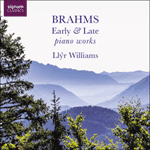 Brahms: Early and late piano works Brahms: Early and late piano worksPraised in The Guardian for his 'unquestionably thoughtful, authoritative playing', Llŷr Williams now offers up a comprehensive exploration of the introspective and expressive piano works of Johannes Brahms.» More |
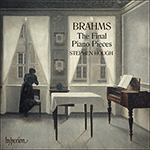 Brahms: The Final Piano Pieces Brahms: The Final Piano PiecesA collection of exquisite Brahmsian miniatures: brief mediations on things final.» More |
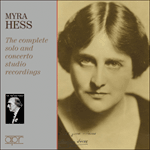 Myra Hess - The complete solo and concerto studio recordings Myra Hess - The complete solo and concerto studio recordings‘In one disc after another you are drawn towards a deeply personal quality that endeared her to thousands … this set will prompt endless reapprai ... ‘A stunning collection of music played by one of the most talented of British pianist’ (MusicWeb International)» More |
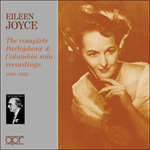 Eileen Joyce - The complete Parlophone & Columbia solo recordings Eileen Joyce - The complete Parlophone & Columbia solo recordings‘Listening to Joyce is strangely addictive. One cannot wait, as it were, to read the next chapter. She shares with Kreisler and Tauber the same unteac ... ‘The quality that comes across in these performances is the sheer joy of playing. Joyce possessed a formidable technique and an interpretative mind th ...» More |
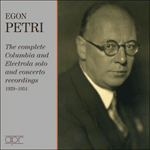 Egon Petri - The complete Columbia and Electrola solo and concerto recordings Egon Petri - The complete Columbia and Electrola solo and concerto recordingsEgon Petri (1881-1962) studied with Busoni and was perhaps his greatest disciple. In his fusion of intellect with an astonishing virtuoso technique he echoed his master and gives us today the clearest idea of Busoni’s own legendary pianism.» More |
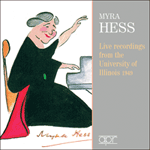 Myra Hess - Live recordings from the University of Illinois, 1949 Myra Hess - Live recordings from the University of Illinois, 1949Two complete recitals recorded at Illinois University on 17 and 18 March 1949 and some bonus recordings originally broadcast on 7 March 1937. Almost all the works included in this programme are new additions to the Myra Hess discography.» More |
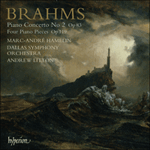 Brahms: Piano Concerto No 2 Brahms: Piano Concerto No 2 |

